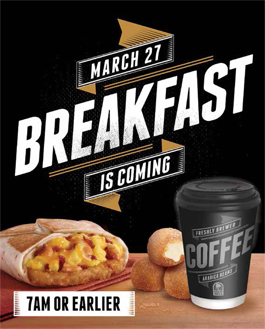
|
Every day two-thirds of consumers eat breakfast, most of it at home. But in the past few years restaurants have been working hard to lure customers away from their kitchens by expanding into the breakfast day part and adding innovative breakfast items.
Taco Bell's breakfast menu, which the company rolled out nationwide earlier this year, was the chain's largest menu expansion in the brand's history, with Taco Bell President Brian Niccol noting that, "Breakfast is the fastest growing day part in QSR."
In order to understand the breakfast landscape, from consumer habits and preferences to opportunities for operators, manufacturers, and distributors, research firm Datassential focused on breakfast for the launch of the new MenuTrends Keynote report series.
"For the first time, we are leveraging the power of our MenuTrends database by combining it with extensive consumer and operator survey data that explores motivations, behaviors and opportunities," said Maeve Webster, Datassential managing director. "The result is a series of comprehensive reports that brings together trends, data and insights that dive deep into key industry topics and categories."
The first MenuTrends Keynote queried 1,280 consumers on their thoughts about a wide range of breakfast dishes, flavors, trends and ingredients. In addition to extensive data on breakfast preferences and motivations, the survey uncovered opportunities for both operators and manufacturers—what drives consumer breakfast decision-making and the trends that will impact both menus and retail in the years ahead.
Millennials
In the past, Datassential's research has shown that Millennials are often not as adventurous as they are perceived. Yet, when it comes to breakfast, they are far more open to new concepts; in fact, they were more interested than any other age group in every adventurous MegaTrend tested, from breakfast dishes influenced by ethnic trends to healthier breakfast options. Nearly 65% were interested in elevated comfort foods, and 63% were interested in monster or mini breakfast sandwiches.
"Creating craveable, innovative breakfast dishes will be key for operators trying to lure Millennials to the breakfast menu, particularly as Millennials are more inclined to skip breakfast than other age group," Webster added. "They are also more likely to eat breakfast outside of traditional morning breakfast hours, and having breakfast foods available during lunch, dinner, or snack times may drive consumption."
Retail Opportunities
Currently food manufacturers are at an advantage, with 83% of consumers reporting that they ate their last breakfast at home and 65% preferring to make or assemble breakfast from scratch. But as more restaurants and on-site operators make a play for the consumer's breakfast dollar, retailers will have to play to their strengths and cater to consumer needs in order to stay ahead. Overall, consumers reported that time, ease, convenience, and health were the most important factors when choosing to eat breakfast at home, preferring foods that were quick to prepare and eat, while noting that cost was the critical factor deterring them from eating breakfast away from home.
Manufacturers may need to renew their focus on convenient, economical products that cater to consumer demands for health and scratch preparation. Convenient speed-scratch products that allow consumers to prepare or assemble at-home meals more conveniently, for instance, such as ready-to-use egg mixes or health and trend-driven carriers like waffle "skinnies" could present opportunities at retail.
Flavor, Cuisine Trends
For both restaurant and on-site operators and manufacturers, understanding breakfast and flavor trends is critical. While traditional breakfast favorites (eggs, bacon) continue to dominate, consumers are getting more adventurous with over half of consumers interested in MegaTrends like elevated comfort foods (chicken and waffles), single-focus restaurants (artisan donuts) and better-for-you concepts (egg whites).
Trends found on lunch and dinner menus are increasingly showing up on breakfast menus. According to Datassential MenuTrends, Southern ingredients like pulled pork, sweet potato, and cornmeal were top growers over the past year, as were ethnic flavors like salsa verde, cotija, and plantains.
And "premium-ization" also was key, with premium cheeses like fontina and aged cheddar growing fast on breakfast menus, providing operators with an easy way to make a breakfast dish more upscale. Better-for-you options are also important -- gluten-free was the fastest growing healthy breakfast term on menus, growing an astonishing 833% in the past four years. Healthy trends are currently at that "sweet spot" in the industry having reached casual chains and QSRs, but also on-site segments such as the supermarket perimeter, lodging, and colleges and universities.
The rapid adoption of both breakfast menus and innovative breakfast items across the industry highlights the importance of in-depth analysis of trends in away-from-home breakfast venues and what factors drive consumer behavior. Breakfast is, after all, the most important meal of the day.
Visit www.datassential.com for additional details.
